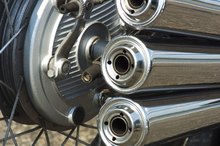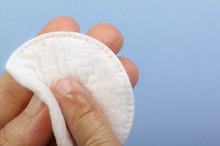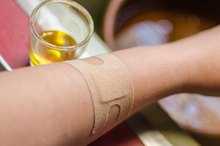How to Heal a Light Skin Burn
A light skin burn would be classified as first-degree and affect only the outer layer of skin. Symptoms of a first-degree burn include reddening, some swelling and pain. If your burn blisters, it has moved beyond the first-degree stage into second-degree. Minor burns may not require professional medical care and rarely scar. If you are unsure of the extent of the burn or the source, you should see a doctor. However, if the burn is first-degree and covers a small surface area, it is possible to provide first-aid at home.
Evaluate the burn. This means determining the source and severity of the burn. If the burn is thermal or mild sunburn, treat this burn with first-aid at home. Skin exposed to a flame or hot object will have a thermal burn. Burns that cover large surface areas or that are on the hands, face, feet or genital area may have complications and require medical evaluation.
How to Prevent Scarring From a Steam Burn
Learn More
Cool the burn immediately with water. Go to the nearest sink and turn on the cold water. Place the burned area under the cold, running water. If the burn is not in an easily accessible spot, then place a cool compress on the area. Saturate a clean towel with cold water and lay it on the burn.
Cover the burn with an antibiotic ointment. Do not apply the ointment until the burn has been cooled. Applying grease or ointment to a hot burn allows skin to continue to burn. Once the cold water has done its job, protect the burn against infection with the antibiotic. It is not necessary to cover the burn 2. Simply smooth the ointment over the area and leave it alone.
How to Treat Burns Caused by Boiling Water
Learn More
Reapply ointment once or twice a day as needed. One application may be enough for very mild burns. Monitor the burn and look for signs of infection. Any open skin, red streaks or drainage may indicate infection. Go to the doctor if the wound is not healing and shows any sign of infection.
Tips
Do not apply ice to a burn. Burned skin may not be sensitive to the damage ice can cause, such as frostbite. Cold water is just as effective and will not further damage the skin.
Warnings
Even a minor burn caused by a chemical, such as acid, requires medical treatment. Do not attempt to treat a chemical burn at home. Get the chemical off the skin if possible following the product directions, and then go to the hospital. Do not assume water is the best choice for a chemical burn. Some chemicals will heat up with water. Read the label and find out how to treat an emergency. Call 911 if you cannot get the chemical off the skin.
Skin is your body’s protection against infection. If the skin breaks open, have a doctor evaluate the wound. Diabetics and those with compromised immune systems should seek out medical care for any burn, even minor.
Related Articles
References
- City of Phoenix: Burn Emergencies
- MayoClinic.com: Burns: First AId
- Knowlin, L., Stanford, L., Moore, D., Cairns, B., & Charles, A. (2016). The Measured Effect Magnitude of Co-Morbidities on Burn injury Mortality. Burns : Journal of the International Society for Burn Injuries, 42(7), 1433–1438. http://doi.org/10.1016/j.burns.2016.03.007
- Hilton G. Thermal Burns: The ABCs are crucial, since the major threat is often inhalation injury. Am J Nurs. 2001;101(11):32-34. doi:10.1097/00000446-200111000-00017
- Cleveland Clinic. Burns. Updated August 31, 2017.
- Thom D. Appraising current methods for preclinical calculation of burn size - A pre-hospital perspective. Burns. 2017;43(1):127-136. doi: 10.1016/j.burns.2016.07.003.
- Knowlin, L., Stanford, L., Moore, D., Cairns, B., & Charles, A. (2016). The Measured Effect Magnitude of Co-Morbidities on Burn injury Mortality. Burns : Journal of the International Society for Burn Injuries, 42(7), 1433–1438.
Writer Bio
Writing since 1999, Darla Ferrara is an award-winning author who specializes in health, diet, fitness and computer technology. She has been published in "Mezzo Magazine" and Diet Spotlight, as well as various online magazines. Ferrara studied biology and emergency medical technology at the University of Nebraska and Southeast Community College.








